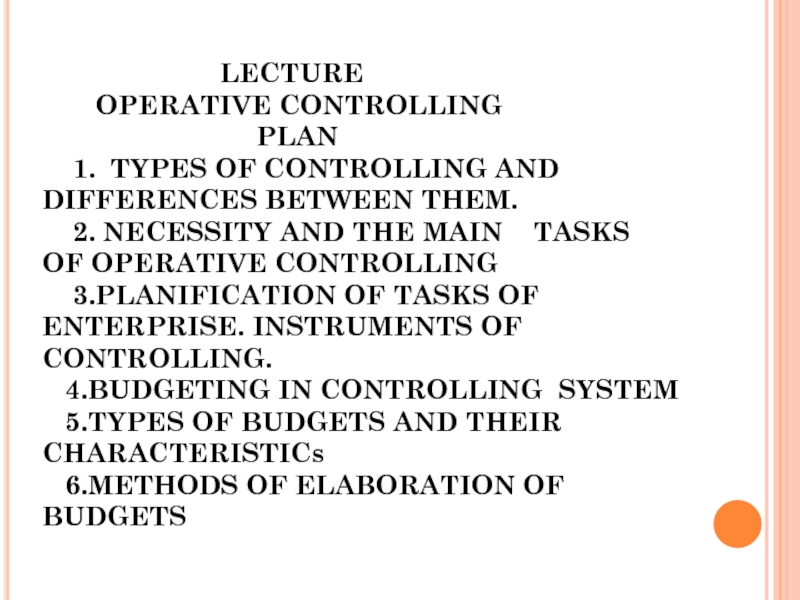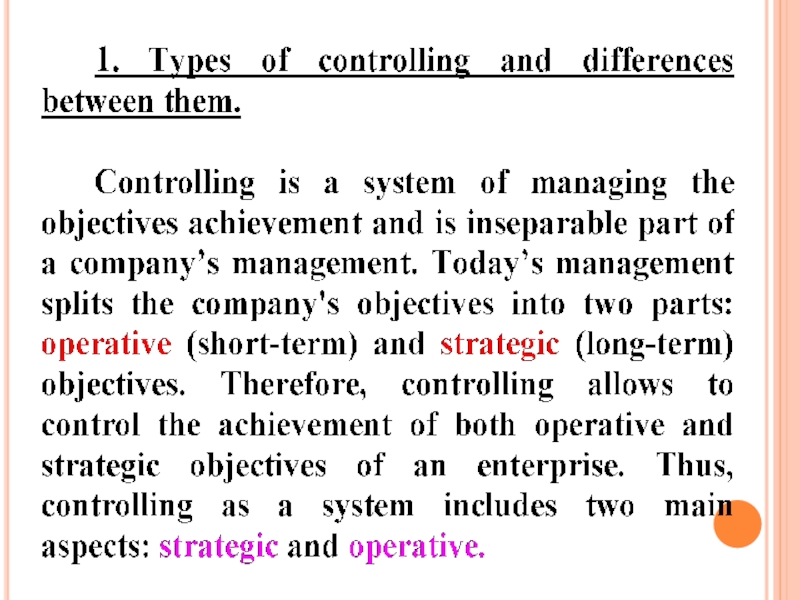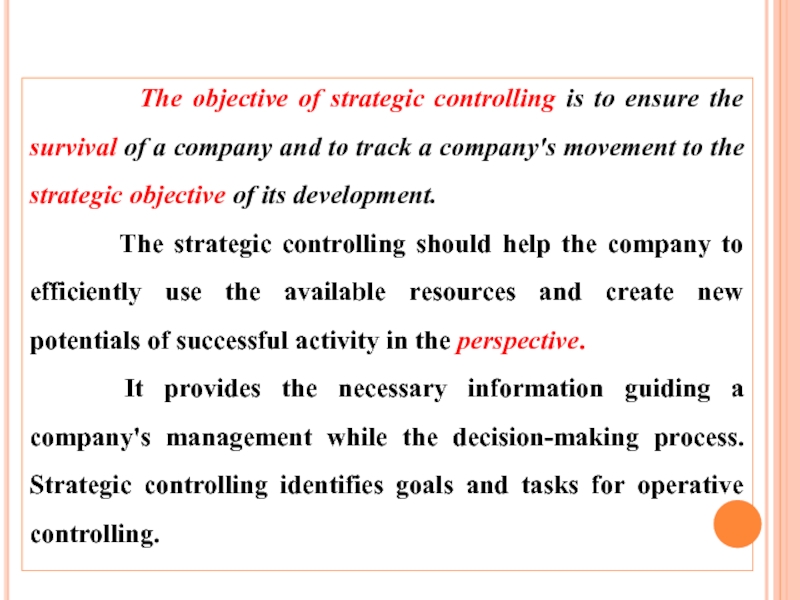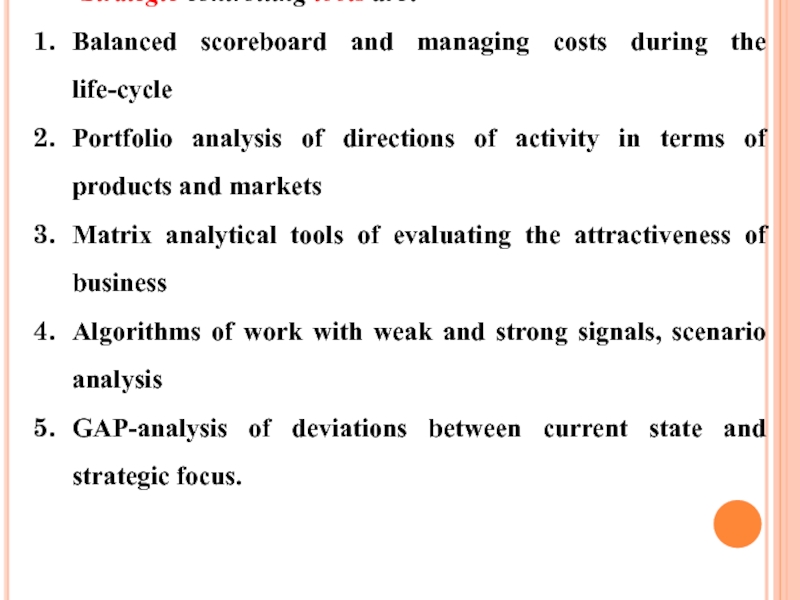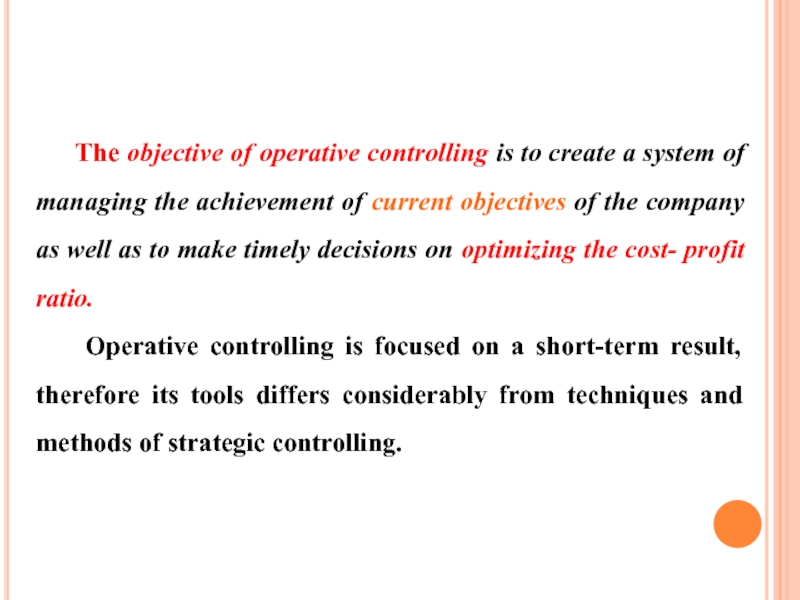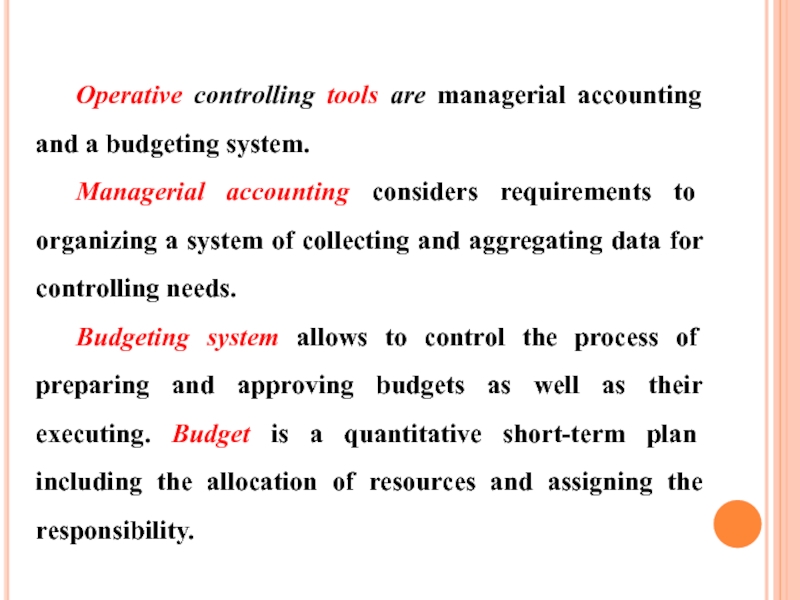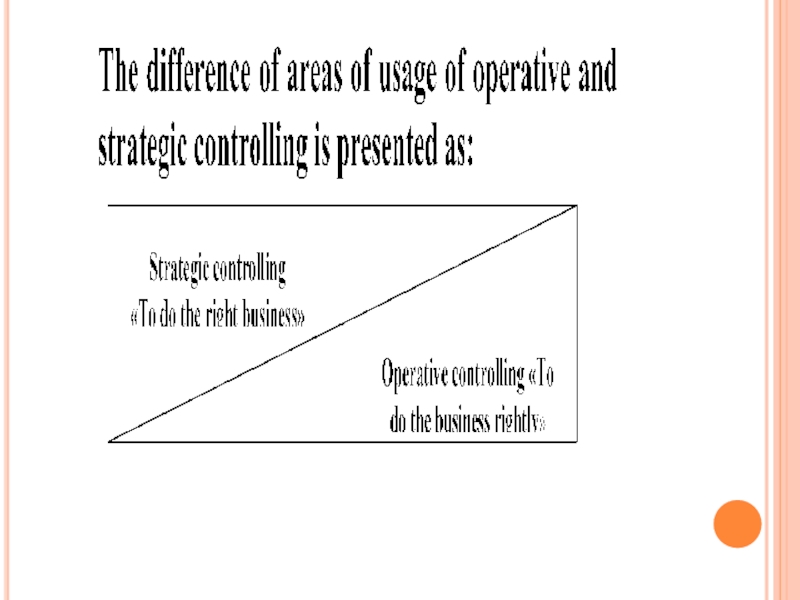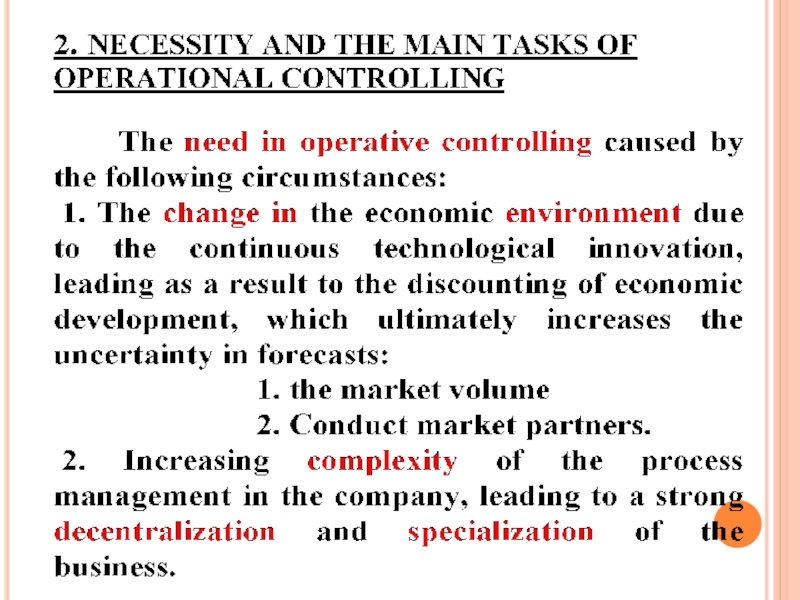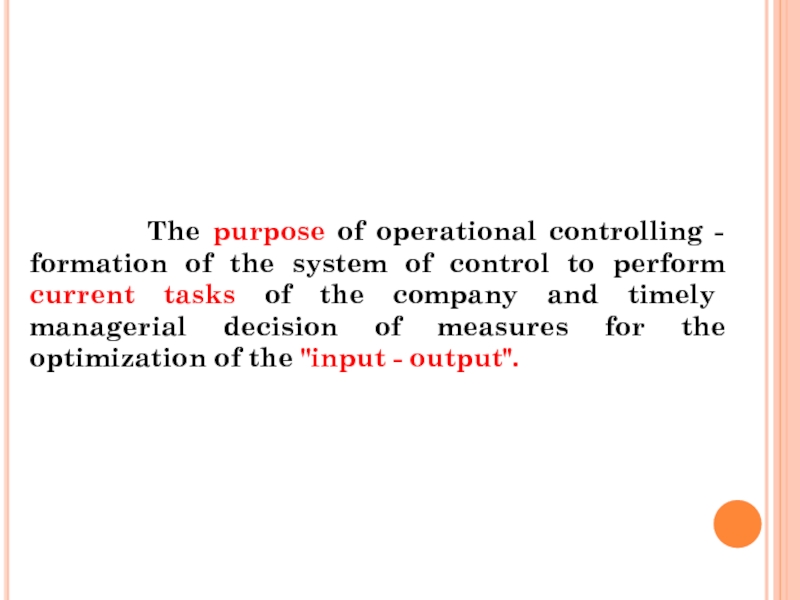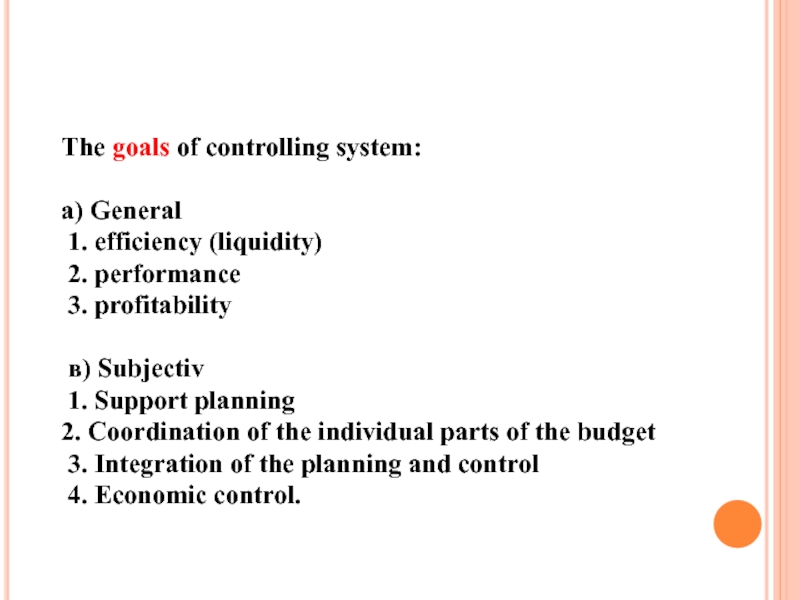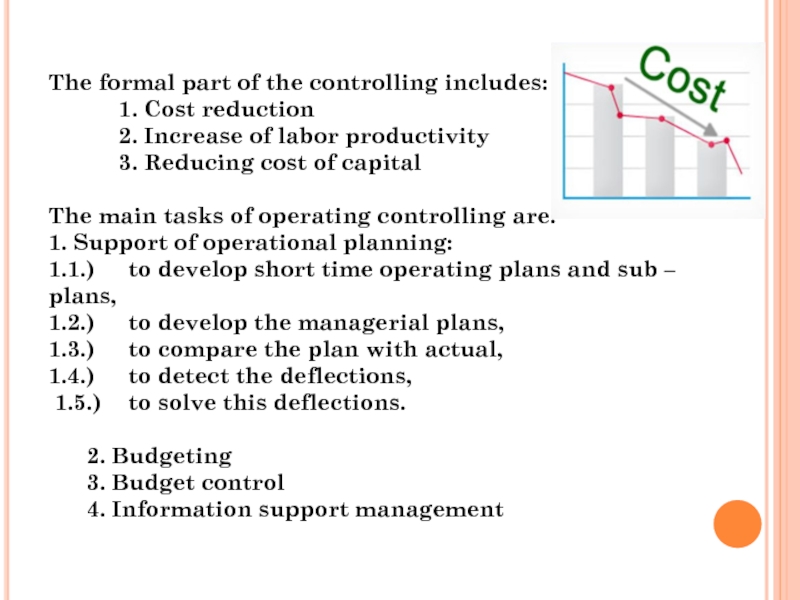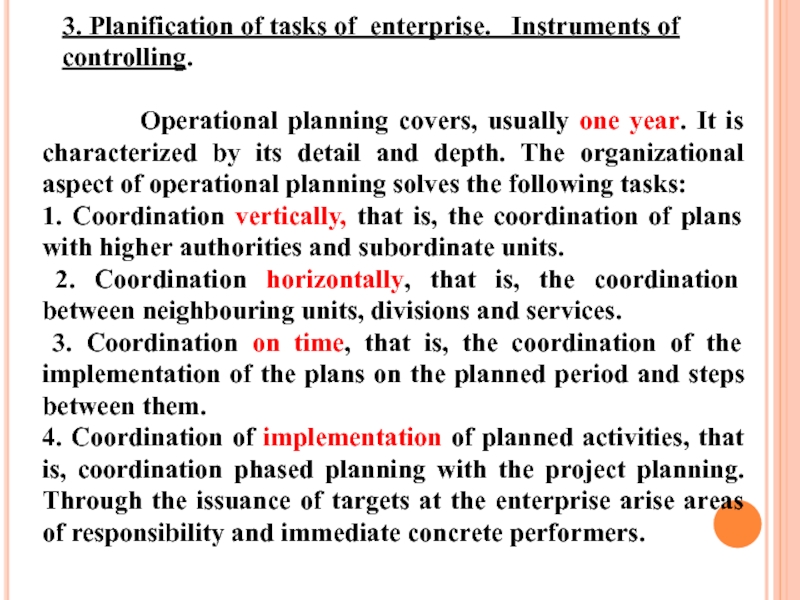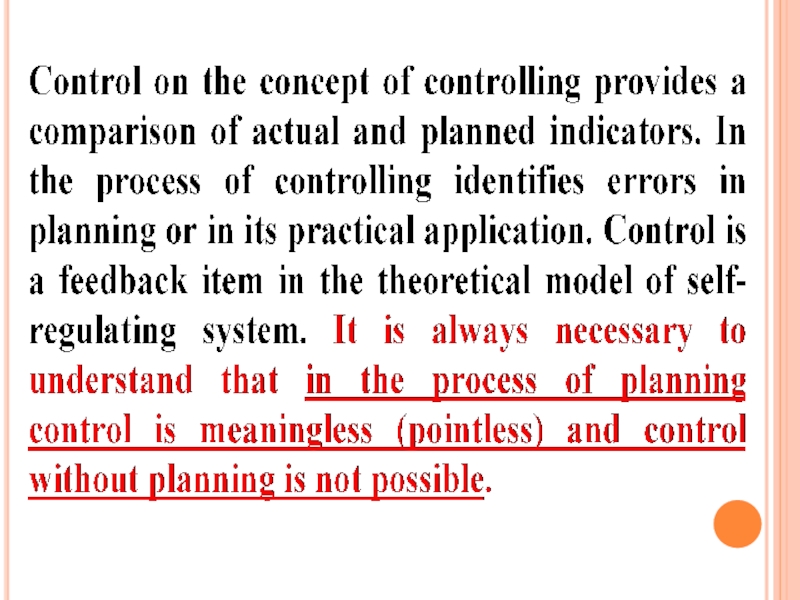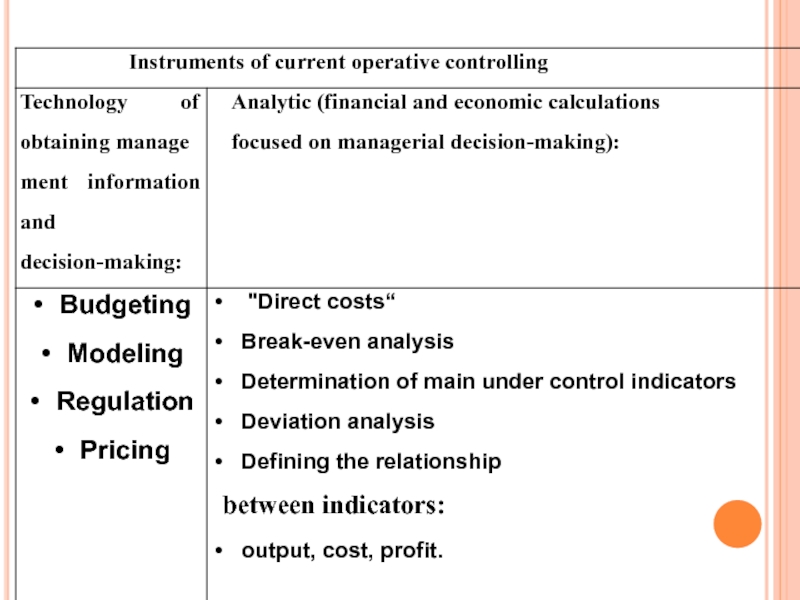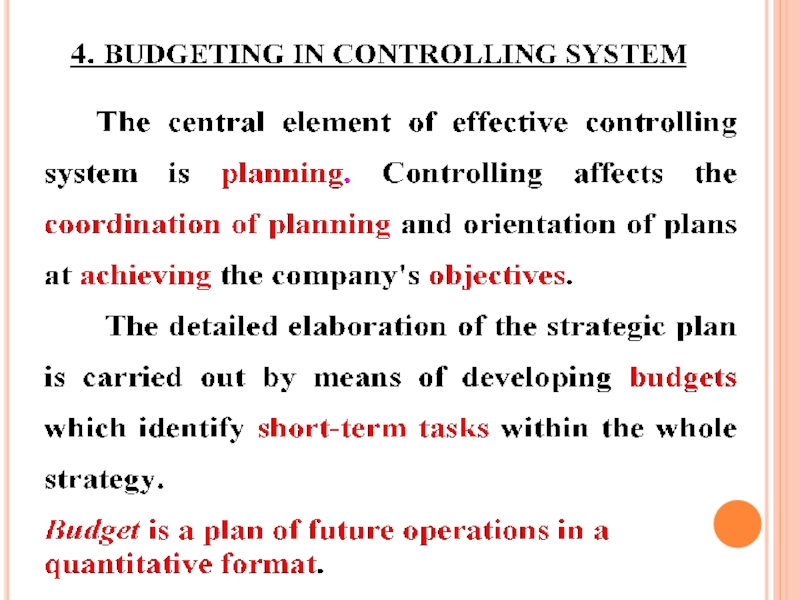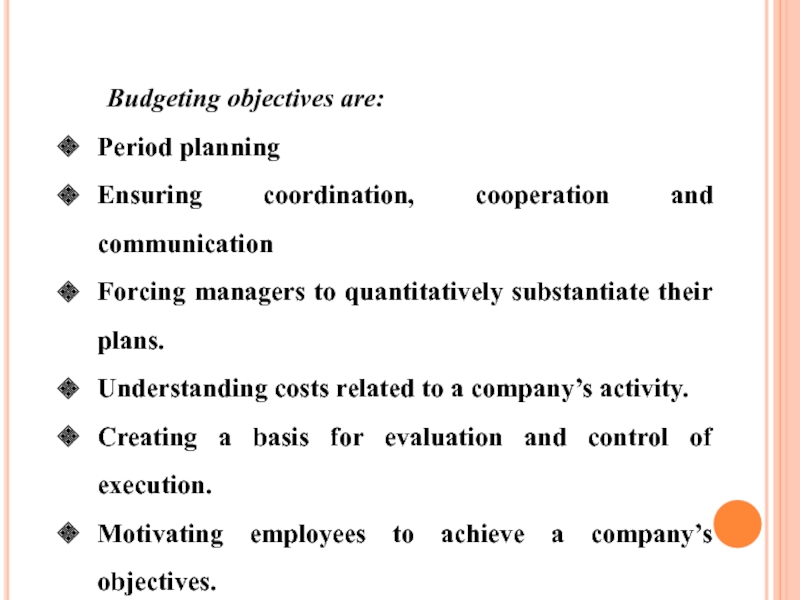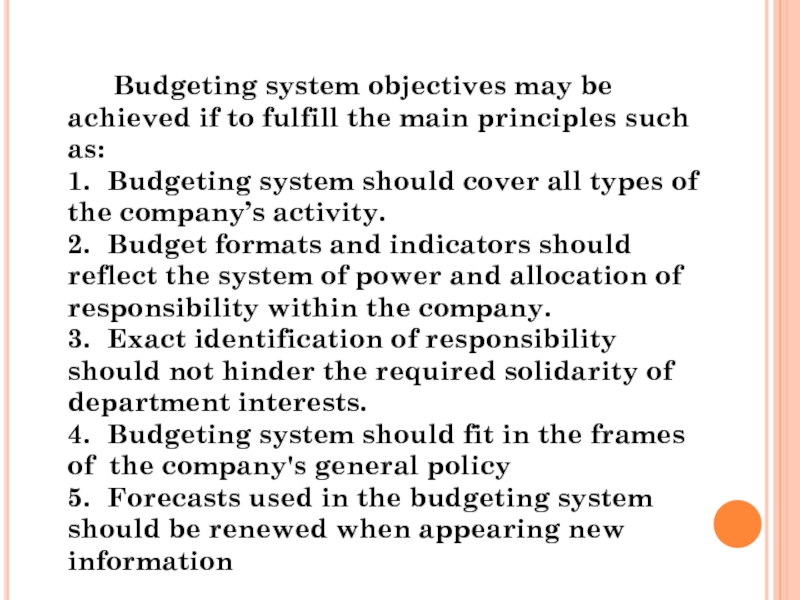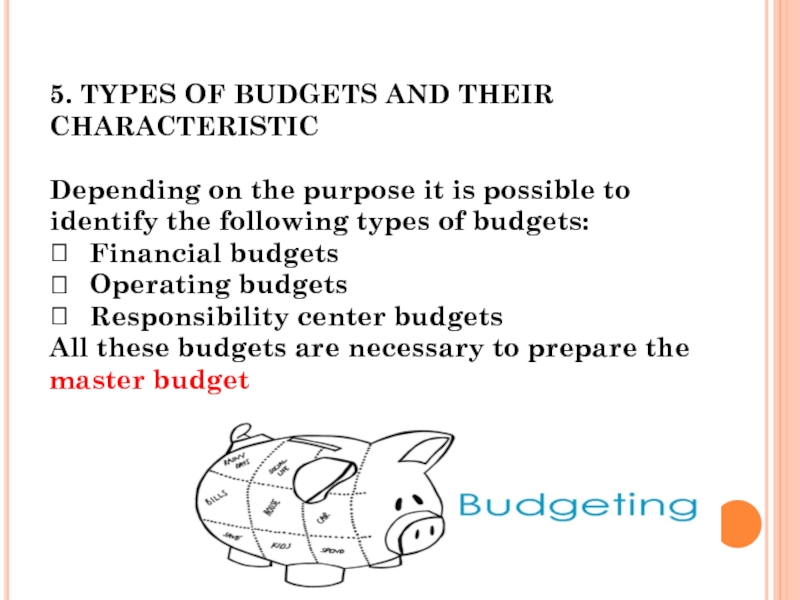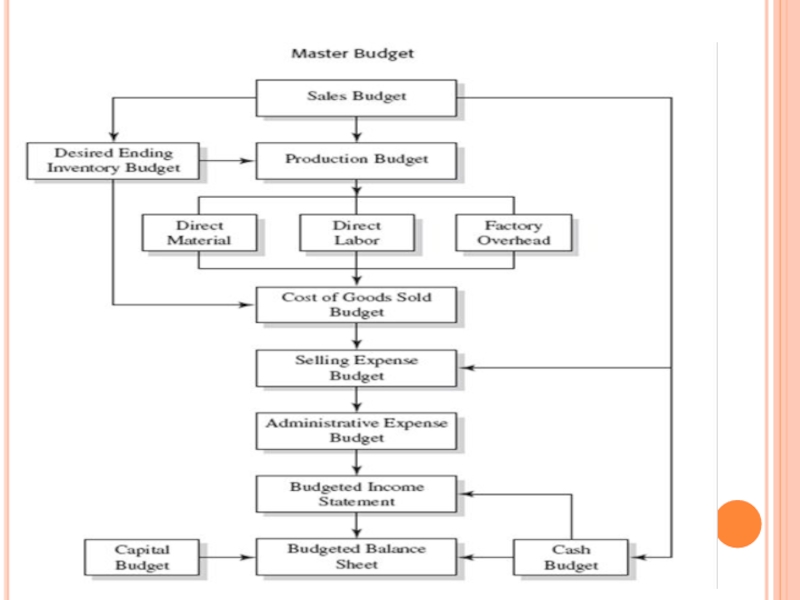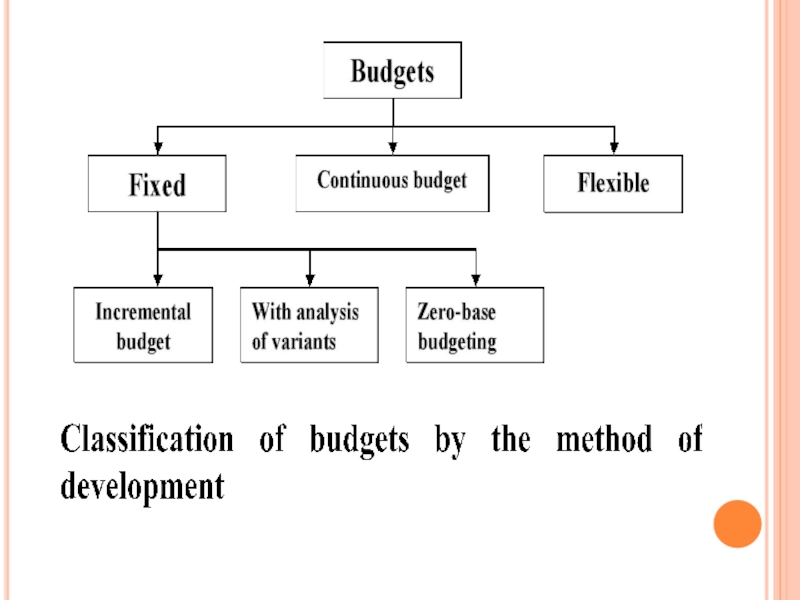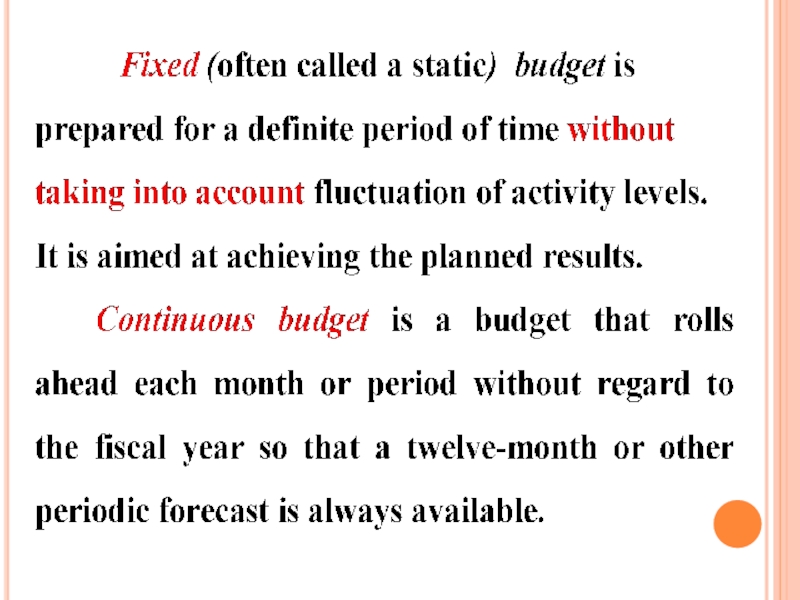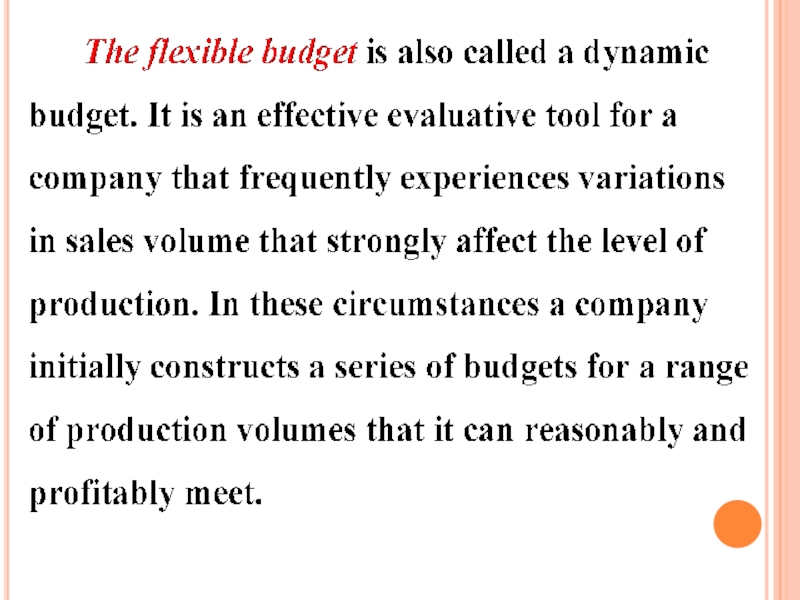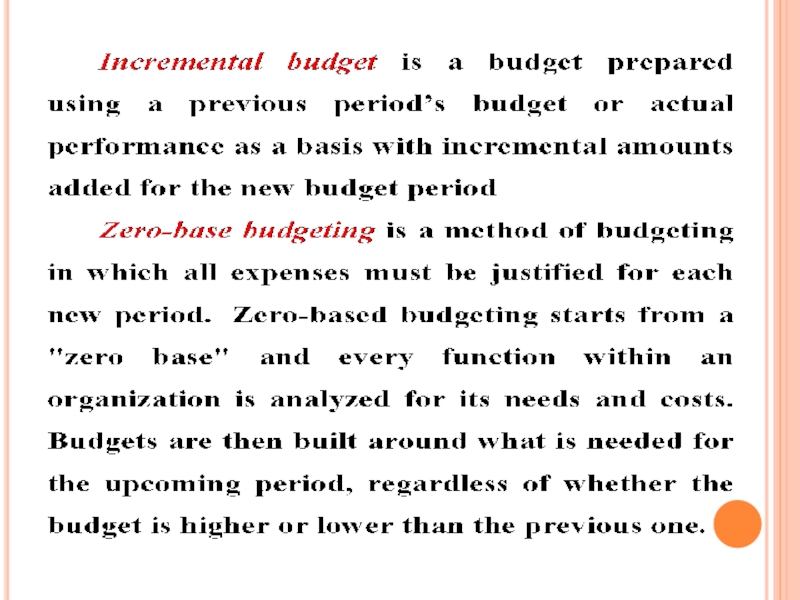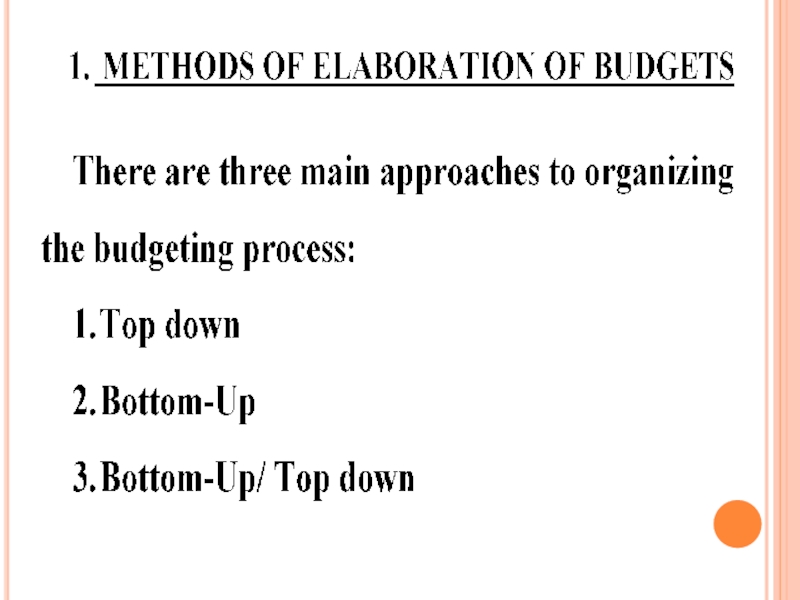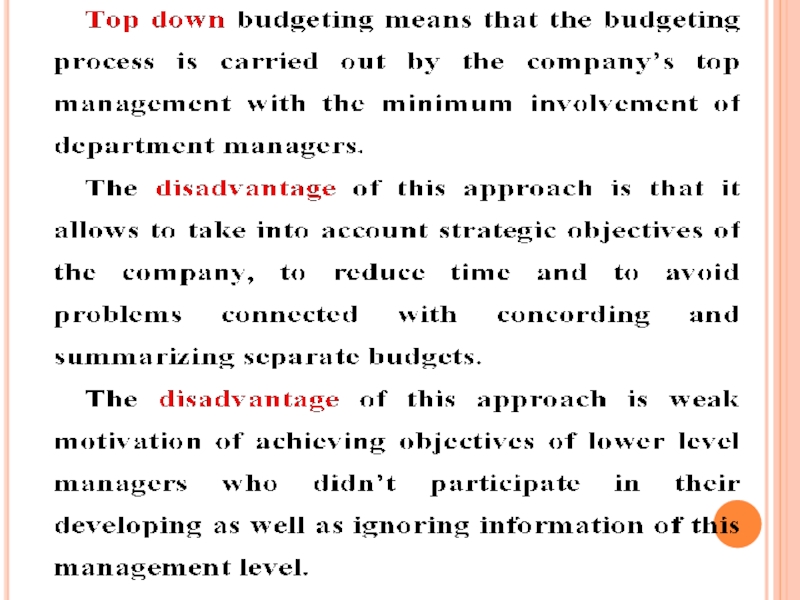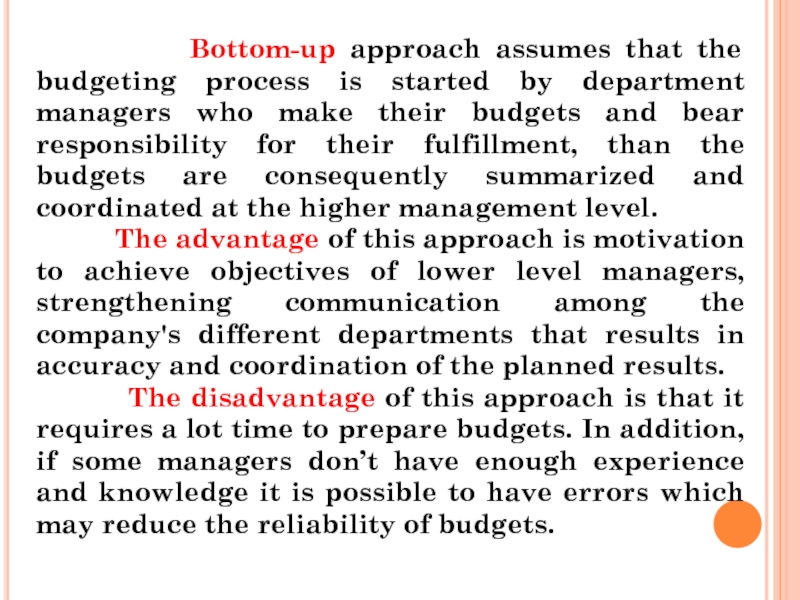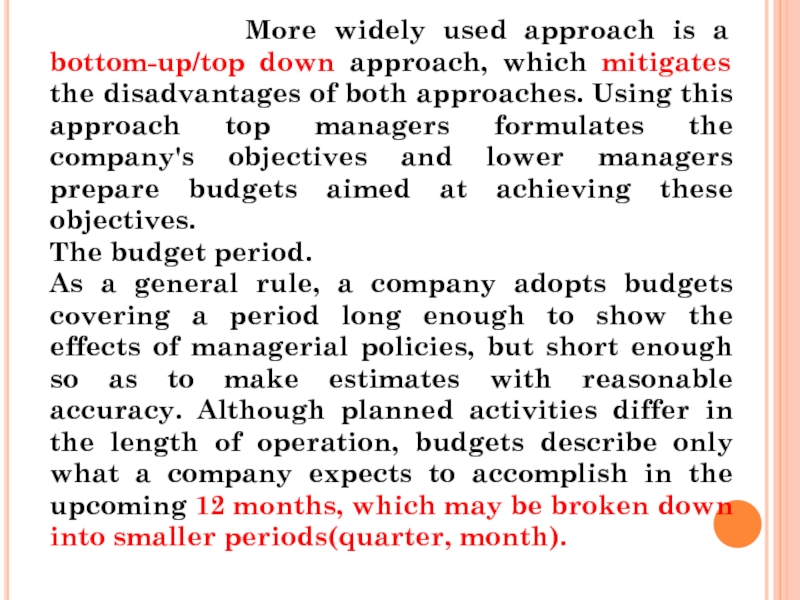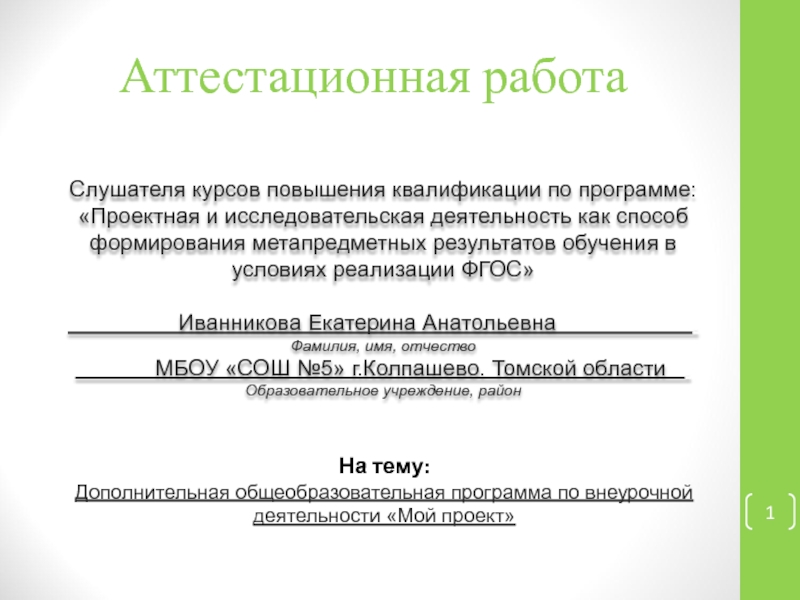- Главная
- Разное
- Дизайн
- Бизнес и предпринимательство
- Аналитика
- Образование
- Развлечения
- Красота и здоровье
- Финансы
- Государство
- Путешествия
- Спорт
- Недвижимость
- Армия
- Графика
- Культурология
- Еда и кулинария
- Лингвистика
- Английский язык
- Астрономия
- Алгебра
- Биология
- География
- Детские презентации
- Информатика
- История
- Литература
- Маркетинг
- Математика
- Медицина
- Менеджмент
- Музыка
- МХК
- Немецкий язык
- ОБЖ
- Обществознание
- Окружающий мир
- Педагогика
- Русский язык
- Технология
- Физика
- Философия
- Химия
- Шаблоны, картинки для презентаций
- Экология
- Экономика
- Юриспруденция
Opertive controlling for the students презентация
Содержание
- 1. Opertive controlling for the students
- 4. The objective of
- 5. Strategic controlling tools are: Balanced scoreboard and
- 6. The objective of operative controlling is to
- 7. Operative controlling tools are managerial accounting and
- 10. The purpose
- 11. The goals of controlling system:
- 12. The formal part of the controlling includes:
- 13. 3. Planification of tasks of enterprise.
- 17. Budgeting objectives are: Period planning Ensuring coordination,
- 18. Budgeting system objectives may
- 19. 5. TYPES OF BUDGETS AND THEIR
- 27. Bottom-up
- 28. More
Слайд 2
LECTURE
OPERATIVE CONTROLLING
PLAN
1. TYPES OF CONTROLLING AND DIFFERENCES BETWEEN THEM.
2. NECESSITY AND THE MAIN TASKS OF OPERATIVE CONTROLLING
3.PLANIFICATION OF TASKS OF ENTERPRISE. INSTRUMENTS OF CONTROLLING.
4.BUDGETING IN CONTROLLING SYSTEM
5.TYPES OF BUDGETS AND THEIR CHARACTERISTICs
6.METHODS OF ELABORATION OF BUDGETS
OPERATIVE CONTROLLING
PLAN
1. TYPES OF CONTROLLING AND DIFFERENCES BETWEEN THEM.
2. NECESSITY AND THE MAIN TASKS OF OPERATIVE CONTROLLING
3.PLANIFICATION OF TASKS OF ENTERPRISE. INSTRUMENTS OF CONTROLLING.
4.BUDGETING IN CONTROLLING SYSTEM
5.TYPES OF BUDGETS AND THEIR CHARACTERISTICs
6.METHODS OF ELABORATION OF BUDGETS
Слайд 4 The objective of strategic controlling is to
ensure the survival of a company and to track a company's movement to the strategic objective of its development.
The strategic controlling should help the company to efficiently use the available resources and create new potentials of successful activity in the perspective.
It provides the necessary information guiding a company's management while the decision-making process. Strategic controlling identifies goals and tasks for operative controlling.
The strategic controlling should help the company to efficiently use the available resources and create new potentials of successful activity in the perspective.
It provides the necessary information guiding a company's management while the decision-making process. Strategic controlling identifies goals and tasks for operative controlling.
Слайд 5Strategic controlling tools are:
Balanced scoreboard and managing costs during the life-cycle
Portfolio
analysis of directions of activity in terms of products and markets
Matrix analytical tools of evaluating the attractiveness of business
Algorithms of work with weak and strong signals, scenario analysis
GAP-analysis of deviations between current state and strategic focus.
Matrix analytical tools of evaluating the attractiveness of business
Algorithms of work with weak and strong signals, scenario analysis
GAP-analysis of deviations between current state and strategic focus.
Слайд 6The objective of operative controlling is to create a system of
managing the achievement of current objectives of the company as well as to make timely decisions on optimizing the cost- profit ratio.
Operative controlling is focused on a short-term result, therefore its tools differs considerably from techniques and methods of strategic controlling.
Operative controlling is focused on a short-term result, therefore its tools differs considerably from techniques and methods of strategic controlling.
Слайд 7Operative controlling tools are managerial accounting and a budgeting system.
Managerial
accounting considers requirements to organizing a system of collecting and aggregating data for controlling needs.
Budgeting system allows to control the process of preparing and approving budgets as well as their executing. Budget is a quantitative short-term plan including the allocation of resources and assigning the responsibility.
Budgeting system allows to control the process of preparing and approving budgets as well as their executing. Budget is a quantitative short-term plan including the allocation of resources and assigning the responsibility.
Слайд 10 The purpose of operational controlling -
formation of the system of control to perform current tasks of the company and timely managerial decision of measures for the optimization of the "input - output".
Слайд 11The goals of controlling system:
a) General
1. efficiency (liquidity)
2.
performance
3. profitability
в) Subjectiv
1. Support planning
2. Coordination of the individual parts of the budget
3. Integration of the planning and control
4. Economic control.
3. profitability
в) Subjectiv
1. Support planning
2. Coordination of the individual parts of the budget
3. Integration of the planning and control
4. Economic control.
Слайд 12The formal part of the controlling includes:
1. Cost reduction
2. Increase of labor productivity
3. Reducing cost of capital
The main tasks of operating controlling are:
1. Support of operational planning:
1.1.) to develop short time operating plans and sub – plans,
1.2.) to develop the managerial plans,
1.3.) to compare the plan with actual,
1.4.) to detect the deflections,
1.5.) to solve this deflections.
2. Budgeting
3. Budget control
4. Information support management
2. Increase of labor productivity
3. Reducing cost of capital
The main tasks of operating controlling are:
1. Support of operational planning:
1.1.) to develop short time operating plans and sub – plans,
1.2.) to develop the managerial plans,
1.3.) to compare the plan with actual,
1.4.) to detect the deflections,
1.5.) to solve this deflections.
2. Budgeting
3. Budget control
4. Information support management
Слайд 133. Planification of tasks of enterprise. Instruments of controlling.
Operational planning covers, usually one year. It is characterized by its detail and depth. The organizational aspect of operational planning solves the following tasks:
1. Coordination vertically, that is, the coordination of plans with higher authorities and subordinate units.
2. Coordination horizontally, that is, the coordination between neighbouring units, divisions and services.
3. Coordination on time, that is, the coordination of the implementation of the plans on the planned period and steps between them.
4. Coordination of implementation of planned activities, that is, coordination phased planning with the project planning. Through the issuance of targets at the enterprise arise areas of responsibility and immediate concrete performers.
1. Coordination vertically, that is, the coordination of plans with higher authorities and subordinate units.
2. Coordination horizontally, that is, the coordination between neighbouring units, divisions and services.
3. Coordination on time, that is, the coordination of the implementation of the plans on the planned period and steps between them.
4. Coordination of implementation of planned activities, that is, coordination phased planning with the project planning. Through the issuance of targets at the enterprise arise areas of responsibility and immediate concrete performers.
Слайд 17Budgeting objectives are:
Period planning
Ensuring coordination, cooperation and communication
Forcing managers to quantitatively
substantiate their plans.
Understanding costs related to a company’s activity.
Creating a basis for evaluation and control of execution.
Motivating employees to achieve a company’s objectives.
Understanding costs related to a company’s activity.
Creating a basis for evaluation and control of execution.
Motivating employees to achieve a company’s objectives.
Слайд 18 Budgeting system objectives may be achieved if to
fulfill the main principles such as:
1. Budgeting system should cover all types of the company’s activity.
2. Budget formats and indicators should reflect the system of power and allocation of responsibility within the company.
3. Exact identification of responsibility should not hinder the required solidarity of department interests.
4. Budgeting system should fit in the frames of the company's general policy
5. Forecasts used in the budgeting system should be renewed when appearing new information
1. Budgeting system should cover all types of the company’s activity.
2. Budget formats and indicators should reflect the system of power and allocation of responsibility within the company.
3. Exact identification of responsibility should not hinder the required solidarity of department interests.
4. Budgeting system should fit in the frames of the company's general policy
5. Forecasts used in the budgeting system should be renewed when appearing new information
Слайд 19
5. TYPES OF BUDGETS AND THEIR CHARACTERISTIC
Depending on the purpose it
is possible to identify the following types of budgets:
Financial budgets
Operating budgets
Responsibility center budgets
All these budgets are necessary to prepare the master budget
Financial budgets
Operating budgets
Responsibility center budgets
All these budgets are necessary to prepare the master budget
Слайд 27 Bottom-up approach assumes that the
budgeting process is started by department managers who make their budgets and bear responsibility for their fulfillment, than the budgets are consequently summarized and coordinated at the higher management level.
The advantage of this approach is motivation to achieve objectives of lower level managers, strengthening communication among the company's different departments that results in accuracy and coordination of the planned results.
The disadvantage of this approach is that it requires a lot time to prepare budgets. In addition, if some managers don’t have enough experience and knowledge it is possible to have errors which may reduce the reliability of budgets.
The advantage of this approach is motivation to achieve objectives of lower level managers, strengthening communication among the company's different departments that results in accuracy and coordination of the planned results.
The disadvantage of this approach is that it requires a lot time to prepare budgets. In addition, if some managers don’t have enough experience and knowledge it is possible to have errors which may reduce the reliability of budgets.
Слайд 28 More widely used approach is
a bottom-up/top down approach, which mitigates the disadvantages of both approaches. Using this approach top managers formulates the company's objectives and lower managers prepare budgets aimed at achieving these objectives.
The budget period.
As a general rule, a company adopts budgets covering a period long enough to show the effects of managerial policies, but short enough so as to make estimates with reasonable accuracy. Although planned activities differ in the length of operation, budgets describe only what a company expects to accomplish in the upcoming 12 months, which may be broken down into smaller periods(quarter, month).
The budget period.
As a general rule, a company adopts budgets covering a period long enough to show the effects of managerial policies, but short enough so as to make estimates with reasonable accuracy. Although planned activities differ in the length of operation, budgets describe only what a company expects to accomplish in the upcoming 12 months, which may be broken down into smaller periods(quarter, month).

